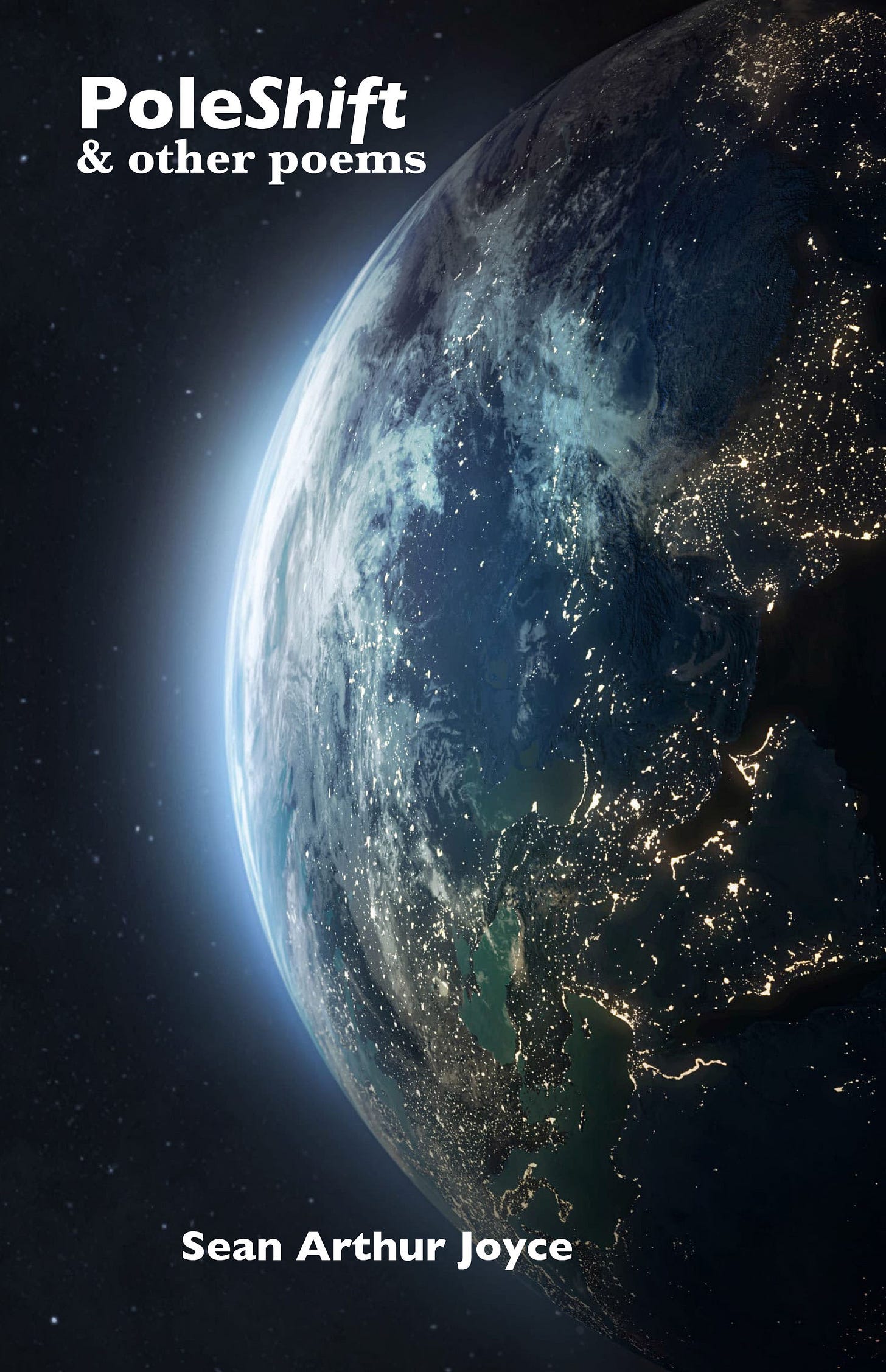“Pole Shift & Other Poems” by Sean Arthur Joyce
A Review by Brian d’Eon
In Pole Shift & Other Poems, Sean Arthur Joyce takes the reader on a dizzying, and often profound, journey. We apologize to bees and oregano plants, marvel at the ancient wing beats of a dragonfly, are haunted by the howls of nearby coyotes, and are even whisked out to distant suns and galaxies. All the universe is Joyce’s playground and his homage to its contents, sacramental.
The collection opens with Joyce’s twelve-part poem, Pole Shift, where Joyce takes as his premise that, while humanity may currently be at its nadir, it may also be at a tipping point, and that nature herself is signaling an imminent and fundamental change—signs such as increased solar activity, volcanism, and an erratic and accelerating migration of our north magnetic pole. In Pole Shift, Joyce taps in to much of humanity’s current grief, asking questions such as:
“What has become
of Athens’ stargazers and their pupils?
Why have our cities blinded
the stars’ eyes? Why are all
the mountaintop lookouts vacant?”
(Pole Shift II)
Later he grieves over our “urge to hammer down / certainty, the spirit’s love / of mystery beclouded.” (Pole Shift VI)
In all his poetry, there is an underlying yearning for connection. Indeed, in his opening epigraph, Joyce quotes Rainer Maria Rilke who writes, “The wall between us is very thin. Why couldn’t a cry from one of us break it down?” (The Book of Hours: Love Poems to God) In almost all his poetry, we hear Joyce echoing this cry—often with powerful imagery and exquisite poetry. “Lean, / lean into the geomagnetic / wind—do not resist—and feel / your skin bristle with feathers” (Pole Shift X) or, later, “cascade / over the lip of the veil, canoes / tumbling down a waterfall, / unafraid of its liquid power, / letting it rain, rain, rain.” (Pole Shift XII)
It would be worth buying Joyce’s book just to bathe in the powerful imagery of Pole Shift, but there is much more.
In “Lament for Gaza,” Joyce leads us into the depths of despair, but our hopes are soon revived in “The Wasteland Awakens” where Joyce writes:
“Raise your cross, your minaret,
your Declaration of Independence,
your menorah. Walk out
in prayer-beaded moss, sing
to skies baptized in blue,
washed clean by love.”
There is a recurring rhythm in these poems: inhalations of hope, exhalations of grief. In “The Bodies of Easter,” Joyce reflects on his/our ultimate fate as our mortal bodies break down. Will we become “a sugar cube dissolved in the rain” or become infused in “another embodied world, another / pair of eyes through which the universe / lives its own countless lives?”
Part Two of Joyce’s collection is entitled Odes to Earth. In these poems, Joyce’s deep connection to the natural world shines, his attention to minute details, indeed his love for the world’s smallest, most modest lifeforms. Speaking to a chickweed plant (“New Arrival”), he whispers, “Welcome—welcome / to the struggle, shouldering / through stone-packed soil / to pierce the lawn’s green thatch.”
The poems of Part Three (e.g. “To My Unborn Children”) are highly personal, confessional, and, at times hard to read, but always filled with beautiful language. Joyce writes of (unborn) daughters “sleek and adoring / as foxes, their ponytails / parting fields of wind-teased flax.”
In Part Four (House of Blues) Joyce continues in his bittersweet voice. Speaking to a Christmas tree, he writes (“Undressing the Tree”), “As I undress you, / I am undressing my own heart / to walk out alone / into the ice-brittle darkness.”
As I close the pages of this magnificent collection, with the glorious imagery still echoing in my head, mostly it is Joyce’s sense of hope that remains in my thoughts, his yearning, his conviction that the wall between us can be lifted. “Teach me the many tongues of love,” Joyce writes (“What Flower is This?”), “the touch that erases the lie of separation, / the song that makes the two one.”


Astonishing review! And well deserved. Congratulations.
I again mention it in my recent overview of my writings on Van Morrison in the 2020s. I (very briefly) say its one of the few works of poetic artistry to really grapple with the era, making it like Morrison's songs of '20-'22. It goes without saying that its words are more crafted and thoughtful than what Morrison was aiming at in his songs. https://dissidentcon.substack.com/p/van-morrison-in-the-2020s